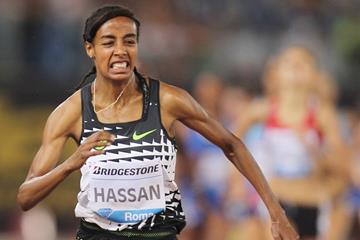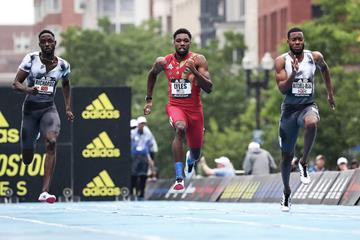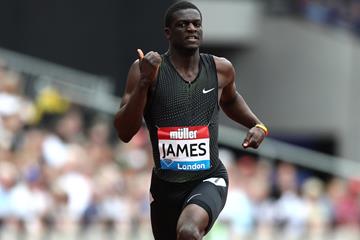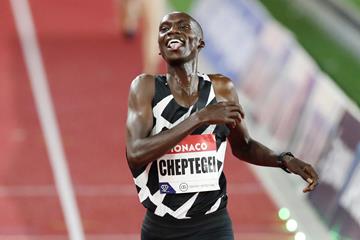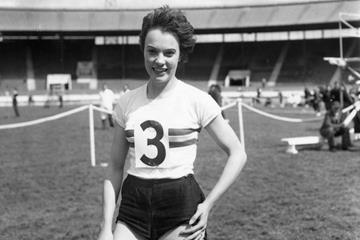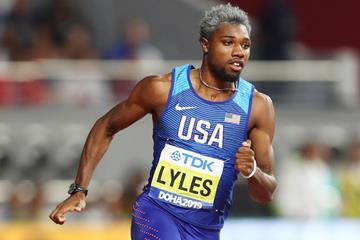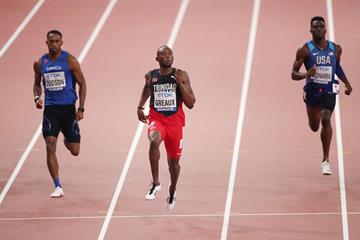 Countdown
Countdown
 Countdown
Countdown
The 200m sprint is a popular track and field event where athletes race around half of a standard 400m outdoor track. For this reason, it’s sometimes known as the ‘half-lap race’.
As a short-distance running event, athletes use all their acceleration, speed and strength in a short but controlled explosion of energy. The winner is the athlete that crosses the finish line first.
The men’s 200m has been an Olympic event since 1900 and has been contested at every Games since (except 1906)
The women’s 200m was introduced in 1948
A 192m version of the event took place at the Ancient Olympics
Athletes begin the race staggered around the bend with the finish line on the home straight – this is so all athletes can stick to their assigned lane and run the exact same distance
Many 100m athletes will also take part in the 200m event, even though the 200m requires a different level of strength and endurance
There are sensors in the starting block and a false start is declared when an athlete’s reactions are less than 0.1 seconds
The 200m is an incredibly fast-paced short-distance race. Along with the 100m sprint, the race has been contested by some of the biggest names in athletics.
The first women’s 200m world record was set by British athlete Alice Cast in August 1922, with a time of 27.8 seconds. During the 1920s, British athletes dominated the event, with Mary Lines and Eileen Edwards also breaking the record throughout the decade. Edwards’ fastest time, set in June 1927 and held for six years, was 25.4 seconds.
The first non-Brit to set a world record in the women’s event was Dutch runner Tollien Schuurman, who set a time of 24.6 in August 1933.
Fast forward to 1977 and World Athletics changed the rules surrounding world records, and only times recorded automatically to one-hundredth of a second were eligible. The final record before this change was achieved by Polish athlete Irena Szewinska, with 22.1.
Since 1977, only four athletes have held the record. East German athletes Marita Koch and Heike Drechsler set six records between May 1978 and August 1986. Dreschsler’s fastest time was 21.71.
Then, in September 1988, US athlete Florence Griffith-Joyner broke the world record twice in one day at the Seoul Olympics. First, Griffith-Joyner set a time of 21.56 seconds. She then followed this with a remarkable 21.34 effort.
The first ever ratified men’s 200m world record was set by US athlete Andy Stanfield in May 1951, with a time of 20.6 seconds. Over the next 24 years, the record was broken 18 times. The first sub-20-second time was set by US runner Tommie Smith in 1968, with 19.83.
Smith held on to the record until September 1979, when Italian athlete Pietro Mennea ran 19.72. Mennea owned the record for 17 years, until US athlete Michael Johnson clocked 19.66 in June 1996. Johnson then improved this effort just five weeks later by running 19.32.
Then, enter Jamaica’s Usain Bolt, the 100m world record-holder, who broke the world 200m record in August 2008 with 19.30. Exactly one year later, Bolt broke his own world record with an incredible time of 19.19. Bolt has held on to the record ever since.
The world indoor 200m records are held by Jamaica’s Merlene Ottey (21.87 in 1993) and Namibia’s Frank Fredericks (19.92 in 1996).
As both the 200m and 100m sprints are very similar short-distance races, many notable 200m athletes have also had a great deal of success running in 100m races. Both require a huge burst of sustained speed, with the major difference being the 200m is – of course – twice the distance of the 100m event. Added to this, the 200m also requires the technical expertise of running a bend at very close to full speed.
In the women’s 200m, other notable athletes include two-time world gold medallist Shericka Jackson, two-time Olympic champion Elaine Thompson-Herah and two-time Olympic gold medallist Veronica Campbell-Brown. Other giants of the sport include Olympic champions Fanny Blankers Koen (1948), Wilma Rudolph (1960), Marie-Jose Pérec (1996) and Allyson Felix (2012).
In Olympic history, the men’s event has served up many unforgettable races, including world record performances for the likes of Jesse Owens (1936), Michael Johnson (1996) and Usain Bolt (2008).
In recent years, Usain Bolt won three Olympic gold medals in the 200m, as well as five World Championships medals. US athlete Noah Lyles has won three world golds and an Olympic bronze. At the Tokyo Olympics, Canadian Andre De Grasse won gold, going one better than his 2016 silver.
The medal ceremony following the men’s 200m final at the 1968 Mexico City Games served up one of the most iconic moments in Olympic history when the gold and bronze medallists from the USA – Tommie Smith and John Carlos – made the Black Power salute, an action later described by Smith as a human rights gesture.

The 200m sprint may only be a short-distance event – with men’s times often clocking in at around 20 seconds – but it requires a huge amount of acceleration, speed, agility and strength. Using the correct 200m running technique can make or break a race.
The best 200m sprint technique can be broken into several phases:
Athletes take their position in their assigned lane at the starting block, where they’re staggered around the bend of a standard 400m track. This ensures that all of the athletes run the exact same distance.
The block is usually arranged so the front block is two feet from the start line and the rear block is three feet from the line. Athletes place their dominant foot in the front block, as this helps them achieve an initial burst of acceleration.
The athlete places their hands on the ground just behind the start line, which helps with balance.
When the call of ‘On your marks,’ is made, athletes get into position with their feet firmly on the starting blocks and their bodies low and centred. They keep their eyes forward and focus on their lane..
‘Set,’ is called to let athletes know the race is about to begin. Athletes raise their hips and tense their leg muscles in anticipation of a huge burst of energy.
The starting pistol is fired and the race begins. Athletes push away from the starting block with both legs, with a sensor in the starting block measuring whether athletes start the race too soon. If a runner commits a false start, they’re immediately disqualified.
Athletes keep their bodies low as they drive forwards, ensuring they take the first quarter of the race with care. This is to ensure that they stay in their lane as they move from the curved section of the track to the straight. Each runner’s strides are big and powerful.
Runners transition so their bodies are upright as they accelerate into the straight. Their strides gradually lengthen as they approach maximum speed.
Athletes reach their fastest speed, with the perfect combination of power, balance and stride length. They pour all their energy and focus into maintaining their speed for as long as possible as discomfort and pain quickly set in.
Athletes focus only on their own performance but may use others ahead of them as inspiration for a final burst of speed as the finish line approaches.
Athletes push their torso forwards to cross the finish line in first position. Even as they near the finish line, athletes shouldn’t slow down as races are often won by hundredths of a second.
The 200m has only a few simple but incredibly important rules to ensure races are safe and fair. Rule breaks can lead to disqualification.
Starting blocks contain electronic sensors which measure if an athlete has a reaction time of less than 0.1 seconds. If so, a false start is declared. With a false start, the race is halted and is restarted. The offending athlete is immediately disqualified.
As well as being disqualified for a false start, athletes may also be disqualified for lane infringement, blocking another athlete or anything deemed as unsportsmanlike behaviour.
The winner of the race is the athlete whose torso is the first to cross the line. If any other body part crosses the line first, including hands, feet and head, these are disregarded.
A wind legal speed in the 200m is anything below 2.0m/s. This is measured using an anemometer placed close to the track. If there is a tailwind of above 2.0m/s, then the race can still take place but the time cannot be used for world record purposes.
In elite competitions, the average men’s 200m sprint time is between 19.50 and 20.50 seconds. Rarely, athletes will achieve better times , including Usain Bolt, who achieved a world record time of 19.19 seconds in August 2009.
The average elite women’s 200m sprint time is between 21.50 and 23 seconds. The women’s world record is currently held by Florence Griffith-Joyner, with a time of 21.34 seconds.
The 200m requires a huge amount of speed and strength, and your timing must be impeccable. Training for the 200m sprint takes time and dedication. It also involves a lot more than just spending time on the track. Here are some points to bear in mind when training for the 200m sprint:
Dedicate time towards strength training, especially exercises to build muscle in your legs. You should also focus on your core
Practice starting a race and use starting blocks with electronic sensors if possible
Improve your footwork and speed with regular agility drills
Ensure you work on your stride length and frequency
Build endurance by running different distances, such as 100m and 400m
Always warm up before training and cool down after training to promote recovery and prevent injury
Have regular rest days to reduce the risk of injury and help with your body’s recovery
Eat a balanced diet, drink plenty of fluids, and try to get eight hours of sleep every night
Creating a training routine can help you balance what you work on and when. For example, day one could be sprinting drills, day two could be strength and weight training, day three could be rest and so on.
 USA
USA
 BOT
BOT
 USA
USA
 JAM
JAM
 DOM
DOM
 GBR
GBR
 USA
USA
 ZIM
ZIM
 USA
USA
 LBR
LBR
 USA
USA
 USA
USA
 USA
USA
 GBR
GBR
 GBR
GBR
 JAM
JAM
 CIV
CIV
 USA
USA
 NGR
NGR
 GBR
GBR
